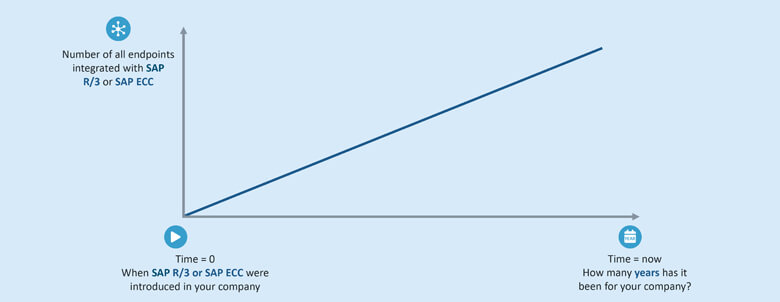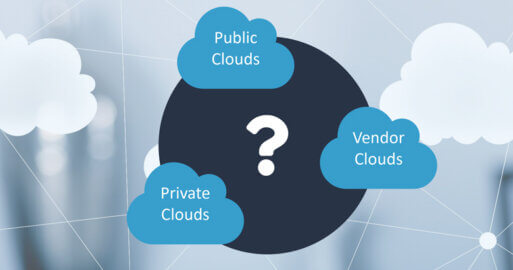Integrating your Existing Products with SAP S/4HANA – Don’t Underestimate the Task!

Several companies are currently facing the mammoth task of implementing SAP S/4HANA in their organisations. Following the announcements that support is being withdrawn for the old system SAP ECC (R/3-Generation) and that the product will not be developed any further, 2021 projections are that existing customers will need to have completely migrated to S/4HANA by 2030 at the latest. Most project managers will be focussing mainly on the processes which need mapping for SAP S/4HANA. However, to ensure that the whole project has a fighting chance to stay on schedule and in budget, equal attention needs to be paid to the related integration needs. Read on to discover why.
The time and costs involved in integrating SAP S/4HANA
Any company, but particularly one which is currently using SAP ECC, would want to be able to minimise the time and costs for introducing S/4HANA. Many, however, tend to underestimate the effort involved in integrating the new system into their existing IT environment. Let’s have a look at the magnitude of this task.
If an SAP customer currently using SAP ECC ‛just’ brings in SAP S/4HANA as his core system, there is a huge risk of overlooking those other systems and applications which have been connected to the current core system since SAP EEC – or even SAP R/3 – was introduced. This is illustrated in a simplistic diagram below:

However long it took to originally connect and integrate all these ancillary systems in a company, when migrating to SAP S/4HANA, this all needs to be done again. Quickly, often one after the other, and running alongside the main project.

The IT research and advisory company GARTNER[1] looked at these time and risk factors back in 2020. Their analysts estimated that by 2025, 40% of the projects implementing an SAP ERP will have been unsuccessful due to having not invested enough in integration. A number of decision makers are already aware of this: 60% estimate that just integrating their legacy systems with SAP S/4HANA will be a significant driver of costs and time. At the same time, a number of firms are considering following a multi-cloud strategy to harness potential cost savings and efficiency gains. However, particularly if you want to benefit from the insights gained through business analytics and intelligence, applications, systems, data sinks and data lakes need to be integrated beyond the cloud/s. In many IT projects, 20%-40% of the planned budget is allocated to integration costs from the beginning as recognition of its importance to the ultimate success of a migration project. These values are a rough range, as it’s difficult to plan exactly what will be needed for integration at the beginning. The challenge for those planning a migration to S4/HANA will be that the proportion of non-SAP applications needing to be integrated has grown in recent years. What this actually means for the project as a whole is difficult to put an exact figure on.
How much of an SAP environment is actually SAP?
For many years, SAP users considered SAP as a kind of one stop shop. If a business unit needed a particular application, they would start by looking at what SAP had to offer. It was felt that as SAP were known for an integrated portfolio of solutions, then ‛things would fit together’ and the customers could benefit from a synergy effect. In the past decade, SAP has left this path somewhat, buying in a number of solutions from third-party software houses – particularly for SAP cloud applications. However, to the relief of their customers, in 2020 SAP started a drive to ensure that certain core products could be integrated with one another. However, a number of their customers had already started using solutions from third parties, as SAP had already lost their reputation of an integrated product portfolio. You can gauge the consequences of this from discussions held between SAP and the German language SAP users association DSAG: on average, only 30% of integration mappings begin or end with an SAP application. That means that 70% of integrative mappings are for non-SAP integrations. This high figure probably doesn’t include mappings between two non-SAP applications, which means:
- The greater majority of integration tasks therefore involve integrating third party applications, legacy systems, external partners and cloud environments.

As the image suggests, we can assume that a company’s central system, such as SAP S/4HANA is responsible for a large volume of these integrations. What’s really important though, is:
- The crux of a well-integrated network is to have seamless connections to nearly all endpoints. It’s therefore not the data volume that is decisive, rather the number of connections required.
And this is where B2B integration, with its demanding list of requirements and need for ultra-high security, has a further characteristic:
- B2B integration has the highest number of endpoints (a company has several business partners, most requiring several different types of transaction to be mapped), yet the average lowest volume per endpoint.
We’ll be looking at B2B integration with SAP S/4HANA in its own blog post. Discover what solutions SEEBURGER can offer you for SAP S/4HANA integration and take a look at articles covering the many aspects which you need to consider in this mammoth task. For one thing is clear: S4/HANA integration is best left to the experts!
[1] See the GARTNER report Magic Quadrant for SAP S/4HANA Application Services, Worldwide – ID G00407891, 30. April 2020
Thank you for your message
We appreciate your interest in SEEBURGER
Get in contact with us:
Please enter details about your project in the message section so we can direct your inquiry to the right consultant.
Written by: Thomas Kamper
Thomas Kamper, SVP Strategic Product Management, is responsible for strategic product initiatives related to all SEEBURGER’s business integration technology and solutions. The focus is currently on API solutions and Big Data. In addition, he is responsible for solutions that enable organizations to master challenges of visibility and to control the proper execution of digitalized business processes. Thomas rejoined SEEBURGER December 2017. Before, he worked for many years as a hands-on interim manager and business advisor supporting C-level executives within software and cloud service providers to make their strategic product initiatives successful.





